Trendlines in WPF Charts (SfChart)
21 Jul 202515 minutes to read
Trendlines are used to analyze and display the trends in the data graphically. It is built on the assumptions based on current and past price trends.
The following code examples illustrate how to add trend lines to the chart.
<syncfusion:ScatterSeries Interior="#4A4A4A" XBindingPath="Year" Label="Series"
ItemsSource="{Binding List}" YBindingPath="India"
ScatterHeight="15" ScatterWidth="15">
<syncfusion:ScatterSeries.Trendlines>
<syncfusion:Trendline Label="Trend" />
</syncfusion:ScatterSeries.Trendlines>
</syncfusion:ScatterSeries>ScatterSeries scatterSeries = new ScatterSeries()
{
ItemsSource = new ViewModel().List,
XBindingPath = "Year",
YBindingPath = "India",
ScatterHeight = 15,
ScatterWidth = 15,
Interior = new SolidColorBrush(Color.FromRgb(0x4A, 0x4A, 0x4A)),
Label = "Series"
};
Trendline trendline = new Trendline()
{
Label ="Trend"
};
scatterSeries.Trendlines.Add(trendline);
chart.Series.Add(scatterSeries);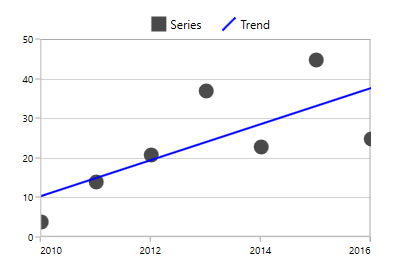
You can get the Slope and Intercept of the drawn trend line.
The visibility of the trend line is defined using IsTrendlineVisible property as in the following code examples.
<syncfusion:ScatterSeries Interior="#4A4A4A" XBindingPath="Year" Label="Series"
ItemsSource="{Binding List}" YBindingPath="India"
ScatterHeight="15" ScatterWidth="15">
<syncfusion:ScatterSeries.Trendlines>
<syncfusion:Trendline Label="Trend" IsTrendlineVisible="False"/>
</syncfusion:ScatterSeries.Trendlines>
</syncfusion:ScatterSeries>ScatterSeries scatterSeries = new ScatterSeries()
{
ItemsSource = new ViewModel().List,
XBindingPath = "Year",
YBindingPath = "India",
ScatterHeight = 15,
ScatterWidth = 15,
Interior = new SolidColorBrush(Color.FromRgb(0x4A, 0x4A, 0x4A)),
Label = "Series"
};
Trendline trendline = new Trendline()
{
Label ="Trend",
IsTrendlineVisible = true
};
scatterSeries.Trendlines.Add(trendline);
chart.Series.Add(scatterSeries);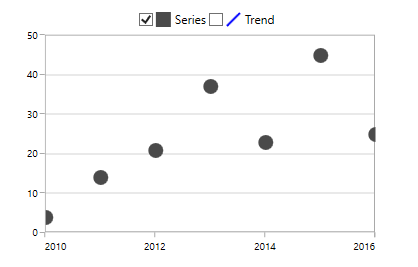
NOTE
Here we have enabled the
CheckBoxVisibilityfor the Legend. The CheckBox state indicates that trendline is not visible. You can enable trendline dynamically using this checkbox.
Types of Trendlines
SfChart supports the following type of Trendlines.
Linear
This shows when something is increasing or decreasing at a steady rate. This is the default trend line to be drawn for the chart.
The linear trend line will be calculated using the below formula:
yValue = Intercept + Slope * xValue ( where xValue is underlying x value).
The following is the code example of this trend line.
<syncfusion:FatLineSeries XBindingPath="Date"
YBindingPath="Value"
Interior="#7F7F7F"
ItemsSource="{Binding StockPriceDetails}">
<syncfusion:FastLineSeries.Trendlines>
<syncfusion:Trendline Stroke="Black" Type="Linear"/>
</syncfusion:FastLineSeries.Trendlines>
</syncfusion:FastLineSeries>FastLineSeries fastSeries = new FastLineSeries()
{
ItemsSource = new ViewModel().StockPriceDetails,
XBindingPath = "Date",
YBindingPath = "Value",
Interior = new SolidColorBrush(Color.FromRgb(0x7f, 0x7f, 0x7f)),
Label = "Stock Price"
};
Trendline trendline = new Trendline()
{
Label = "Trend",
Stroke =new SolidColorBrush(Colors.Black),
Type = TrendlineType.Linear
};
fastSeries.Trendlines.Add(trendline);
chart.Series.Add(fastS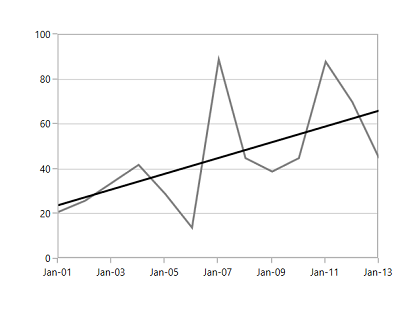
Exponential
This trend line is used when there is a constant increasing or decreasing in values. This is a curved line.
The linear trend line will be calculated using the below formula:
(InterceptMath.Exp(SlopexValue)) (where xValue is underlying x value).
The following code example defines the exponential trendline.
<syncfusion:FastLineSeries XBindingPath="Date"
YBindingPath="Value"
Interior="#7F7F7F"
ItemsSource="{Binding StockPriceDetails}">
<syncfusion:FastLineSeries.Trendlines>
<syncfusion:Trendline Stroke="Black" Type="Exponential"/>
</syncfusion:FastLineSeries.Trendlines>
</syncfusion:FastLineSeries>FastLineSeries fastSeries = new FastLineSeries()
{
ItemsSource = new ViewModel().StockPriceDetails,
XBindingPath = "Date",
YBindingPath = "Value",
Interior = new SolidColorBrush(Color.FromRgb(0x7f, 0x7f, 0x7f)),
Label = "Stock Price"
};
Trendline trendline = new Trendline()
{
Label = "Trend",
Stroke =new SolidColorBrush(Colors.Black),
Type = TrendlineType.Exponential
};
fastSeries.Trendlines.Add(trendline);
chart.Series.Add(fastS
NOTE
This is not recommended for the data values having zero and negative value.
Power
This trend line is used for comparing multiple sets of data that increase at specific rate.
This will be calculated using the following formula:
(Intercept*Math.Pow(xValue,Slope)) (Where xValue is underlying x value).
The following code example explains how to define the power trendline.
<syncfusion:FastLineSeries XBindingPath="Date"
YBindingPath="Value"
Interior="#7F7F7F"
ItemsSource="{Binding StockPriceDetails}">
<syncfusion:FastLineSeries.Trendlines>
<syncfusion:Trendline Stroke="Black" Type="Power"/>
</syncfusion:FastLineSeries.Trendlines>
</syncfusion:FastLineSeries>FastLineSeries fastSeries = new FastLineSeries()
{
ItemsSource = new ViewModel().StockPriceDetails,
XBindingPath = "Date",
YBindingPath = "Value",
Interior = new SolidColorBrush(Color.FromRgb(0x7f, 0x7f, 0x7f)),
Label = "Stock Price"
};
Trendline trendline = new Trendline()
{
Label = "Trend",
Stroke =new SolidColorBrush(Colors.Black),
Type = TrendlineType.Power
};
fastSeries.Trendlines.Add(trendline);
chart.Series.Add(fastS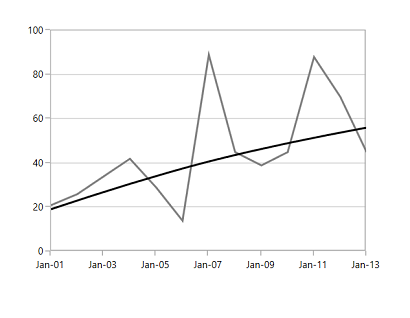
Logarithmic
This is used when there is a quick change in the data, either increasing or decreasing and then levels out.
The will be calculated using the below formula:
Intercept+Slope * Math.Log(xValue) (where xValue is underlying x value).
The following code example illustrates the use of logarithmic trend line.
<syncfusion:FastLineSeries XBindingPath="Date"
YBindingPath="Value"
Interior="#7F7F7F"
ItemsSource="{Binding StockPriceDetails}">
<syncfusion:FastLineSeries.Trendlines>
<syncfusion:Trendline Stroke="Black" Type="Logarithmic"/>
</syncfusion:FastLineSeries.Trendlines>
</syncfusion:FastLineSeries>FastLineSeries fastSeries = new FastLineSeries()
{
ItemsSource = new ViewModel().StockPriceDetails,
XBindingPath = "Date",
YBindingPath = "Value",
Interior = new SolidColorBrush(Color.FromRgb(0x7f, 0x7f, 0x7f)),
Label = "Stock Price"
};
Trendline trendline = new Trendline()
{
Label = "Trend",
Stroke =new SolidColorBrush(Colors.Black),
Type = TrendlineType.Logarithmic
};
fastSeries.Trendlines.Add(trendline);
chart.Series.Add(fastS
Polynomial
The polynomial trendline is a curved line that is used when there are more data fluctuations.
The polynomial trendline is calculated using the below formula:
PolynomialSlopes.Select( ( value,index)=>value*Math.Pow (xValue,(double)index)).Sum() (where xValue is underlying x value)
To define the polynomial trendline, you can use the following code example.
<syncfusion:FastLineSeries XBindingPath="Date"
YBindingPath="Value"
Interior="#7F7F7F"
ItemsSource="{Binding StockPriceDetails}">
<syncfusion:FastLineSeries.Trendlines>
<syncfusion:Trendline Stroke="Black" Type="Polynomial"/>
</syncfusion:FastLineSeries.Trendlines>
</syncfusion:FastLineSeries>FastLineSeries fastSeries = new FastLineSeries()
{
ItemsSource = new ViewModel().StockPriceDetails,
XBindingPath = "Date",
YBindingPath = "Value",
Interior = new SolidColorBrush(Color.FromRgb(0x7f, 0x7f, 0x7f)),
Label = "Stock Price"
};
Trendline trendline = new Trendline()
{
Label = "Trend",
Stroke =new SolidColorBrush(Colors.Black),
Type = TrendlineType.Polynomial
};
fastSeries.Trendlines.Add(trendline);
chart.Series.Add(fastS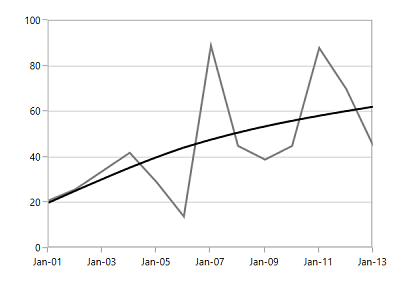
Polynomial Order
You can set the Polynomial order for this trendline. Polynomial order calculates order based on the equation and this value should fall between 2 and 6.
<syncfusion:FastLineSeries XBindingPath="Date"
YBindingPath="Value"
Interior="#7F7F7F"
ItemsSource="{Binding StockPriceDetails}">
<syncfusion:FastLineSeries.Trendlines>
<syncfusion:Trendline Stroke="Black" Type="Polynomial"
PolynomialOrder="5"/>
</syncfusion:FastLineSeries.Trendlines>
</syncfusion:FastLineSeries>FastLineSeries fastSeries = new FastLineSeries()
{
ItemsSource = new ViewModel().StockPriceDetails,
XBindingPath = "Date",
YBindingPath = "Value",
Interior = new SolidColorBrush(Color.FromRgb(0x7f, 0x7f, 0x7f)),
Label = "Stock Price"
};
Trendline trendline = new Trendline()
{
Label = "Trend",
Stroke =new SolidColorBrush(Colors.Black),
Type = TrendlineType.Polynomial,
PolynomialOrder = 5
};
fastSeries.Trendlines.Add(trendline);
chart.Series.Add(fastSeries);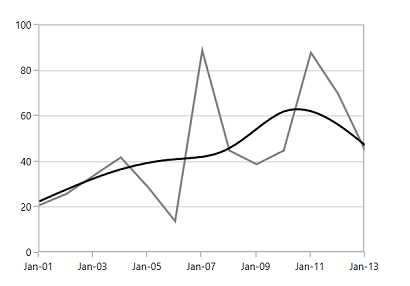
Forecasting
Chart supports forecasting for the trendline, which is used to display trends about the future and the past.
The following two types of forecasting available in SfChart:
- Forward Forecasting
- Backward Forecasting
Forward Forecast
For determining the future trends (in forward direction). The following code example explains the how to set the value for ForwardForecast.
<syncfusion:FastLineSeries XBindingPath="Date" YBindingPath="Value"
Label="Stock Price" Interior="#7F7F7F"
ItemsSource="{Binding StockPriceDetails}">
<syncfusion:FastLineSeries.Trendlines>
<syncfusion:Trendline Stroke="Black"
Type="Polynomial" PolynomialOrder="3" ForwardForecast="5" />
</syncfusion:FastLineSeries.Trendlines>
</syncfusion:FastLineSeries>FastLineSeries fastSeries = new FastLineSeries()
{
ItemsSource = new ViewModel().StockPriceDetails,
XBindingPath = "Date",
YBindingPath = "Value",
Interior = new SolidColorBrush(Color.FromRgb(0x7f, 0x7f, 0x7f)),
Label = "Stock Price"
};
Trendline trendline = new Trendline()
{
Label = "Trend",
Stroke =new SolidColorBrush(Colors.Black),
Type = TrendlineType.Polynomial,
PolynomialOrder = 3,
ForwardForecast = 5
};
fastSeries.Trendlines.Add(trendline);
chart.Series.Add(fastSeries);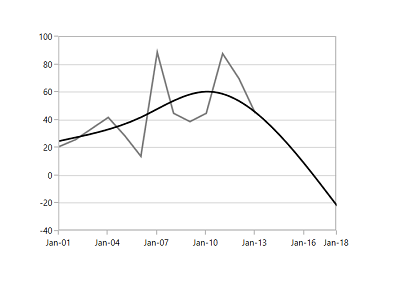
Backward Forecast
For determining the past trends (in backward direction). The following code example explains the how to set the value for BackwardForecast.
<syncfusion:FastLineSeries XBindingPath="Date" YBindingPath="Value"
Label="Stock Price" Interior="#7F7F7F"
ItemsSource="{Binding StockPriceDetails}">
<syncfusion:FastLineSeries.Trendlines>
<syncfusion:Trendline Stroke="Black"
Type="Polynomial" PolynomialOrder="3" BackwardForecast="5" />
</syncfusion:FastLineSeries.Trendlines>
</syncfusion:FastLineSeries>FastLineSeries fastSeries = new FastLineSeries()
{
ItemsSource = new ViewModel().StockPriceDetails,
XBindingPath = "Date",
YBindingPath = "Value",
Interior = new SolidColorBrush(Color.FromRgb(0x7f, 0x7f, 0x7f)),
Label = "Stock Price"
};
Trendline trendline = new Trendline()
{
Label = "Trend",
Stroke =new SolidColorBrush(Colors.Black),
Type = TrendlineType.Polynomial,
PolynomialOrder = 3,
BackwardForecast = 5
};
fastSeries.Trendlines.Add(trendline);
chart.Series.Add(fastSeries);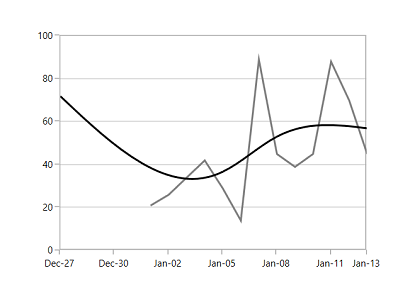
Customization
You can customize the trendline Stroke, StrokeThickness and StrokeDashArray as in below code example.
<syncfusion:FastLineSeries XBindingPath="Date" YBindingPath="Value"
Label="Stock Price" Interior="#7F7F7F"
ItemsSource="{Binding StockPriceDetails}">
<syncfusion:FastLineSeries.Trendlines>
<syncfusion:Trendline Stroke="Black" Type="Linear"
StrokeDashArray="4,4" StrokeThickness="2" />
</syncfusion:FastLineSeries.Trendlines>
</syncfusion:FastLineSeries>FastLineSeries fastSeries = new FastLineSeries()
{
ItemsSource = new ViewModel().StockPriceDetails,
XBindingPath = "Date",
YBindingPath = "Value",
Interior = new SolidColorBrush(Color.FromRgb(0x7f, 0x7f, 0x7f)),
Label = "Stock Price"
};
Trendline trendline = new Trendline()
{
Label = "Trend",
Stroke = new SolidColorBrush(Colors.Black),
Type = TrendlineType.Linear,
StrokeThickness = 2,
StrokeDashArray = new DoubleCollection() { 4, 4 }
};
fastSeries.Trendlines.Add(trendline);
chart.Series.Add(fastSeries);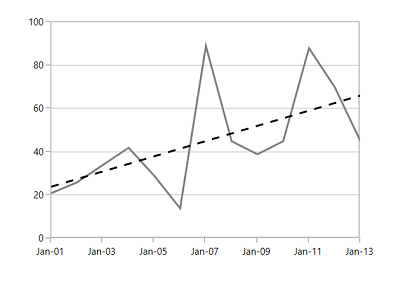
NOTE
You can refer to our WPF Charts feature tour page for its groundbreaking feature representations. You can also explore our WPF Charts example to knows various chart types and how to easily configured with built-in support for creating stunning visual effects.